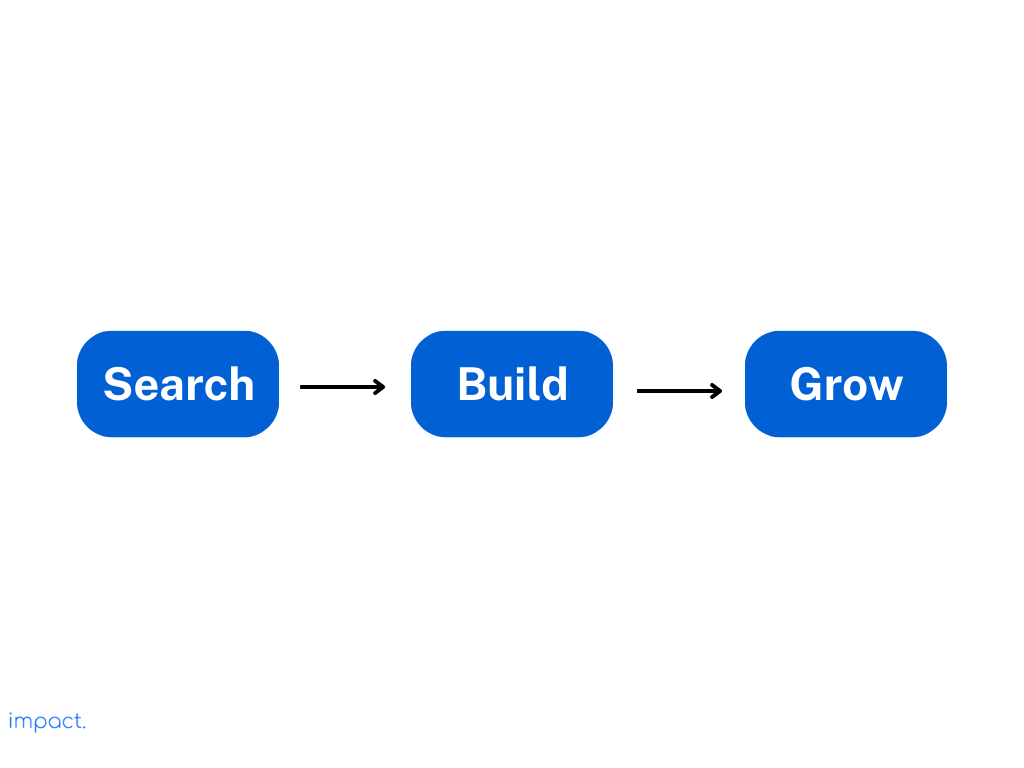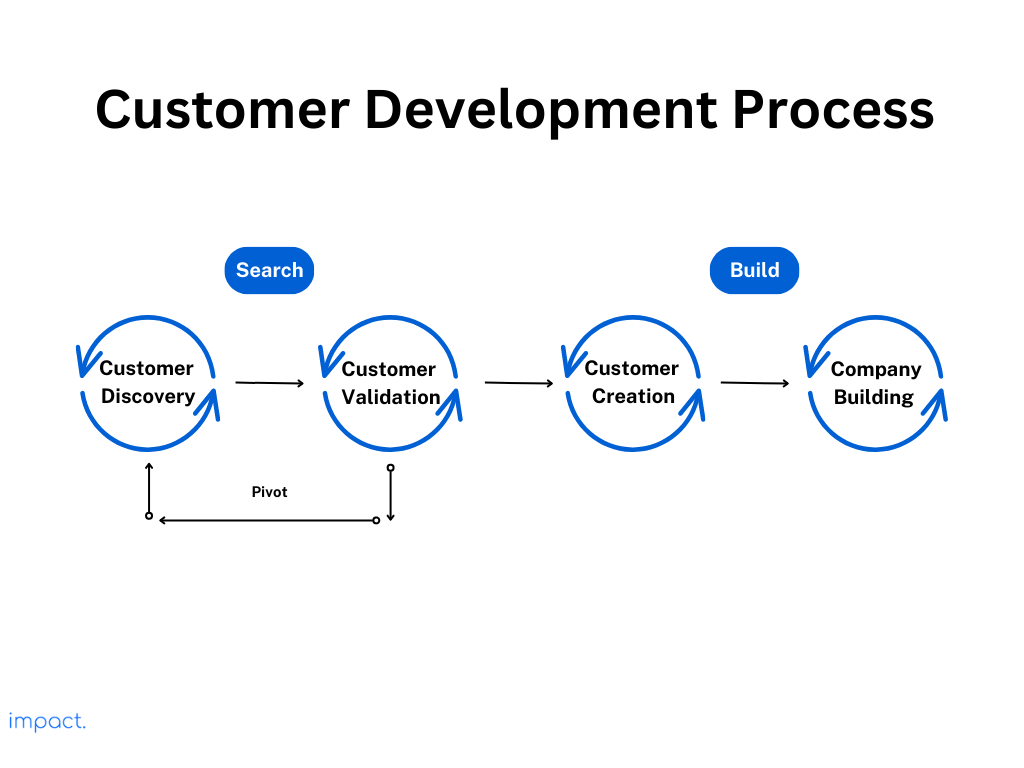Blue Ocean Strategy: 7 Steps to Ignite Business Transformation
“Blue Ocean Strategy,” by W. Chan Kim and Renée Mauborgne, is a pioneering blue ocean…
Insight Team
January 1, 2025In the previous chapter, we learned about startups and the common mistakes that can lead to their failure. One essential lesson is the need to understand your customers to succeed.
In “The Startup Owner’s Manual” by Steve Blank and Bob Dorf, they talk about how many startups struggle because they lack a structured way to test their ideas. The Customer Development model is like a helpful guide that assists startups in finding a business model they can repeat and scale successfully.
Now, let’s explore the different stages and components of the Customer Development process. This process helps startups search for a business model that works by understanding and validating the needs of their target market and customers. It’s a key to making your startup successful.
In the 1990s, Steve Blank came up with the customer development process when he noticed that startups aren’t just smaller versions of big companies. He realized entrepreneurs need a structured way to find “repeatable and scalable business models.”
According to Blank, startups go through three stages before becoming big companies: search, build, and grow.

The customer development process lies within the search and build stage.
There are four steps in the customer development process:
The first two steps of the process are about finding a suitable business model (search). Once you have a model developed, tested, and proven in these initial steps, steps three and four are all about putting that model into action and making it work (build/execution).

In the Customer Development model, each step is like a circular track with arrows showing that we go through the steps repeatedly. In simpler terms, it means that startups can be unpredictable. We might face failures and make mistakes multiple times before figuring things out correctly.
Read more: Startup Essentials: Key Definition and 9 Mistakes to Avoid
Now that you know what a customer development process is, let’s dive into what exactly happens in this process. We’ll break down the whole process into four stages and explain the steps involved in each phase.
In the customer development process, the first step is called customer discovery. Here, founders take their ideas for the company and turn them into hypotheses like educated guesses. Then, they create experiments to test these hypotheses.
Steve Blank stresses the value of leaving your workspace and engaging with people directly. This approach means going out and conversing with them to gain deeper insights. In the customer discovery process, there are two main components of “getting out of the building”:
Once founders collect all the necessary information in this stage, they can move on to the next step, customer validation.
During customer validation, startups check if their solution meets customers’ needs and their business idea can work. If everything looks good, they can get ready to sell the product and grow the business.
In this phase, startups test their scalability. They see if their business can handle more customers, find the right price, and reach them effectively. They also create a sales plan for future sales and marketing teams or see how well their online marketing works with early customers.
The first two steps of the Customer Development model are essential for improving and testing the business idea. The entrepreneur makes a minimum viable product (MVP) or a prototype with the most critical features. They show this MVP to potential customers and ask for their feedback. This feedback is valuable because it helps the entrepreneur improve the product using real-world insights.
After achieving sustainable growth, startups can shift their focus to the customer creation step. However, during this validation phase, startups may sometimes discover that their initial assumptions were off-base or that the market’s needs have shifted. In such cases, a pivot may be necessary. We will discuss pivoting in detail in upcoming chapters.
Read more: Unlocking Growth: 19 Traction Channels for Business Success
Once startups have confirmed that customers are interested in their idea, they move on to the next step: customer creation. This step is where they put their business plan into action.
The main goal is to create a reliable system for attracting new customers and fueling business growth. During this stage, the team chooses their target market, sets clear goals, and fine-tunes their positioning strategy in preparation for the product launch.
At this point, startups have learned how to get customers without spending much money on marketing. They use the product/market fit they discovered earlier to develop effective marketing and sales strategies that reach a wider audience.
The way startups create customers can vary depending on their market. Some compete with established companies, while others explore new areas. Some use a combination of strategies by targeting a specific segment or finding a unique niche.
In the customer development process, the final step is company building. At this stage, the business is no longer considered a startup and no longer focuses on searching for solutions.
Now, the main goal is to scale the business. Startups move their efforts from learning and exploring to taking action. They set up organized departments such as Sales, Marketing, and Business Development, each led by a Vice President (VP).
To succeed at scaling, the company must change its organizational structure. The changes could mean hiring new people with specific skills that the current team doesn’t have. It might also involve some team members leaving if their goals no longer match the company’s goals. And in some instances, the founder might not be the best person to lead a successful company anymore.
As the company grows, the team gets more prominent, and they make operations work even better. They might create new departments to help different areas communicate and work together more effectively.
Embracing the customer development process has many benefits for entrepreneurs. It helps them succeed and create thriving businesses that meet their customers’ real needs. Here are some of those advantages:
The harsh reality of startups is that 90% fail and some don’t even survive beyond their first year. A significant factor contributing to these failures is a lack of customer understanding. Many founders assume they know what customers want, but the truth is often different.
The customer development process helps you identify your potential customer’s pain points, preferences, and unmet needs. With this valuable knowledge, you can customize your product or service to address those issues directly. This targeted approach significantly boosts the chances of your offering gaining traction and success in the market.
Startups can be chaotic, with constant changes happening all the time. Markets are constantly evolving, and what customers like can change quickly. Understanding your target customers and what they need to stay competitive is essential.
Customer development helps with this. It means talking and listening to your potential and current customers to get feedback and insights. This ongoing conversation enables you to keep up with new trends, shifts in demand, and changing customer preferences. With this valuable information, you can make intelligent changes to your products, services, or business strategies at the right time.
With the validation process, you don’t need to aim for perfection immediately. Begin with a Minimum Viable Product (MVP) that satisfies early customers. Remember, the MVP isn’t the final version, but it helps you get feedback from real users.
Releasing the minimum viable product (MVP) can be advantageous. It allows you to enter the market swiftly, gain momentum faster, and begin generating revenue while refining your product.
When you release the MVP to your target customers and ask for their feedback, you learn important things about your product. You discover what it does well, what needs improvement, and what’s missing. This feedback helps you make real-world improvements based on what customers like.
This development process helps you avoid spending too much on a fully developed product that might not match the market’s needs. Instead, you listen to customer feedback to guide your product’s growth, making it more aligned with what customers want. The constant refining based on customer input leads to a better user experience and happier customers, which can build loyalty and positive word-of-mouth.
Understanding and meeting customer needs is vital for startup success. As discussed in “The Startup Owner’s Manual” by Steve Blank and Bob Dorf, the Customer Development process offers a straightforward way for startups to find a winning business model.
The process has four steps: Customer Discovery, Customer Validation, Customer Creation, and Company Building, which are like a circle that startups repeat. It’s normal to face failures and mistakes along the way. Still, startups can discover a sustainable business model through learning and adapting.
The next chapter will focus on building a company using the customer development manifesto. This manifesto provides 14 guiding principles for founders, ensuring a customer-focused approach. By embracing these principles, startups can create a strong foundation for growth and success.
Blank, Steve, and Bob Dorf. The Startup Owner’s Manual: The Step-By-Step Guide for Building a Great Company. 2020.
Impact Insight Team
Impact Insights Team is a group of professionals comprising individuals with expertise and experience in various aspects of business. Together, we are committed to providing in-depth insights and valuable understanding on a variety of business-related topics & industry trends to help companies achieve their goals.
75% of digital transformation projects fail. Take the right first step by choosing a reliable long-term partner.
